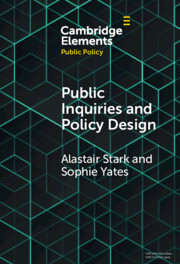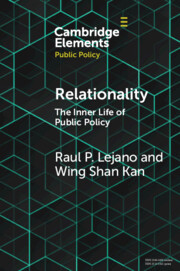36 results

Bad Public Policy
- Malignity, Volatility and the Inherent Vices of Policymaking
-
- Published online:
- 07 April 2025
- Print publication:
- 31 May 2025
-
- Element
-
- You have access
- Open access
- HTML
- Export citation
10 - The Massachusetts Commission on LGBTQ Youth
- from II - What Legal Design Can Do
-
-
- Book:
- Legal Design
- Published online:
- 19 December 2024
- Print publication:
- 19 December 2024, pp 149-158
-
- Chapter
- Export citation
14 - The Stanford Legal Design Lab
- from III - How Legal Design Works
-
-
- Book:
- Legal Design
- Published online:
- 19 December 2024
- Print publication:
- 19 December 2024, pp 228-237
-
- Chapter
- Export citation
Democratic Policymakers’ Ambiguous Support for Reparations: Implications for the Policymaking Process
-
- Journal:
- Journal of Race, Ethnicity and Politics , First View
- Published online by Cambridge University Press:
- 19 December 2024, pp. 1-30
-
- Article
-
- You have access
- Open access
- HTML
- Export citation

Public Contracting for Social Outcomes
-
- Published online:
- 12 December 2024
- Print publication:
- 12 December 2024
-
- Element
-
- You have access
- Open access
- HTML
- Export citation
The purpose of policy portfolios: design, intention, and logic
-
- Journal:
- Journal of Public Policy / Volume 44 / Issue 4 / December 2024
- Published online by Cambridge University Press:
- 31 October 2024, pp. 809-825
-
- Article
-
- You have access
- Open access
- HTML
- Export citation
Optimal surrender policy for reverse mortgage loans
-
- Journal:
- ASTIN Bulletin: The Journal of the IAA / Volume 54 / Issue 3 / September 2024
- Published online by Cambridge University Press:
- 24 September 2024, pp. 600-625
- Print publication:
- September 2024
-
- Article
-
- You have access
- HTML
- Export citation

Designing Behavioural Insights for Policy
- Processes, Capacities & Institutions
-
- Published online:
- 24 April 2024
- Print publication:
- 16 May 2024
-
- Element
- Export citation

Public Inquiries and Policy Design
-
- Published online:
- 06 February 2024
- Print publication:
- 23 May 2024
-
- Element
- Export citation
The People’s Intervention: How #BlackLivesMatter Circumvented a Culture of Congruent Criminal Justice Policies in American States
-
- Journal:
- Journal of Race, Ethnicity and Politics / Volume 9 / Issue 1 / March 2024
- Published online by Cambridge University Press:
- 15 January 2024, pp. 123-156
-
- Article
-
- You have access
- Open access
- HTML
- Export citation
Not that basic: how level, design, and context matter for the redistributive outcomes of universal basic income
-
- Journal:
- Journal of Social Policy / Volume 54 / Issue 2 / April 2025
- Published online by Cambridge University Press:
- 07 December 2023, pp. 351-373
- Print publication:
- April 2025
-
- Article
-
- You have access
- Open access
- HTML
- Export citation
7 - A Tale of Two Automated States
- from Part II - Automated States
-
-
- Book:
- <i>Money, Power, and AI</i>
- Published online:
- 16 November 2023
- Print publication:
- 30 November 2023, pp 136-151
-
- Chapter
-
- You have access
- Open access
- HTML
- Export citation
12 - Popular Sovereignty and Recognition
- from Part II
-
-
- Book:
- When the People Rule
- Published online:
- 23 November 2023
- Print publication:
- 09 November 2023, pp 218-233
-
- Chapter
-
- You have access
- Open access
- HTML
- Export citation
4 - Do They Make a Difference? The Policy Impact of Populist Radical Right Parties in Local Power
-
- Book:
- Restrained Radicals
- Published online:
- 10 August 2023
- Print publication:
- 10 August 2023, pp 101-135
-
- Chapter
- Export citation
5 - Making Government Policy Credible
-
- Book:
- Uncertain Futures
- Published online:
- 06 July 2023
- Print publication:
- 20 July 2023, pp 116-146
-
- Chapter
- Export citation
10 - How the Sharing Economy is Reshaping the Dynamics of Neighborhoods
- from Part II-A - Ride Sharing, Mobility, and Lodging
-
-
- Book:
- Reengineering the Sharing Economy
- Published online:
- 30 March 2023
- Print publication:
- 06 April 2023, pp 167-188
-
- Chapter
-
- You have access
- Open access
- HTML
- Export citation
9 - Increasing Shareability in Ride-Pooling Systems
- from Part II-A - Ride Sharing, Mobility, and Lodging
-
-
- Book:
- Reengineering the Sharing Economy
- Published online:
- 30 March 2023
- Print publication:
- 06 April 2023, pp 146-166
-
- Chapter
-
- You have access
- Open access
- HTML
- Export citation
8 - Understanding the Impact of Ridesharing Services on Traffic Congestion
- from Part II-A - Ride Sharing, Mobility, and Lodging
-
-
- Book:
- Reengineering the Sharing Economy
- Published online:
- 30 March 2023
- Print publication:
- 06 April 2023, pp 119-145
-
- Chapter
-
- You have access
- Open access
- HTML
- Export citation
8 - Redress Policy Design and Delivery
- from Part III
-
- Book:
- Monetary Redress for Abuse in State Care
- Published online:
- 18 November 2022
- Print publication:
- 01 December 2022, pp 119-138
-
- Chapter
-
- You have access
- Open access
- HTML
- Export citation

Relationality
- The Inner Life of Public Policy
-
- Published online:
- 23 November 2022
- Print publication:
- 22 December 2022
-
- Element
-
- You have access
- Open access
- HTML
- Export citation


